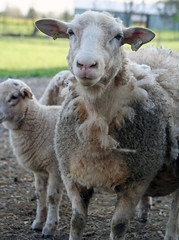Researchers in the United Kingdom set out to unlock the genetics of wool shedding. They concluded that wool shedding is most likely controlled by a single dominant gene on a non-sex chromosome. But, the speed and extent of shedding varies by animal and is a polygenic trait, just like commonly recorded traits, such as weaning weights.
In a flock of shedding breeds (Dorper, Katahdin, Wiltshire Horn, and Easycare), shedding score (1-5; 1=no shedding, 5=complete shedding) was determined to have a heritability of 0.54 +0.07 in lambs and 0.26 +0.06 in animals of all ages. Shedding score as a lamb had a genetic correlation of 0.94 +0.08 with shedding score as a 2 year old, but at the phenotypic level was only 0.39 +0.05.
According to the researchers, breeding for increased wool shedding ability is possible. First, the dominant gene needs to be introduced into the flock. Then, selection between animals can be done to improve the speed and extent of shedding.
Wool shedding is a valuable trait in situations where the cost of producing and harvesting wool exceeds its value. In the U.S., Canada, Australia, and Europe, more and more producers are turning to hair or "shedding" sheep to increase their profitability and/or ease of management.
Source: Abstract. J. Animal Science, August 2011
 |
| Beginning to shed |
According to the researchers, breeding for increased wool shedding ability is possible. First, the dominant gene needs to be introduced into the flock. Then, selection between animals can be done to improve the speed and extent of shedding.
Wool shedding is a valuable trait in situations where the cost of producing and harvesting wool exceeds its value. In the U.S., Canada, Australia, and Europe, more and more producers are turning to hair or "shedding" sheep to increase their profitability and/or ease of management.
Source: Abstract. J. Animal Science, August 2011

No comments:
Post a Comment